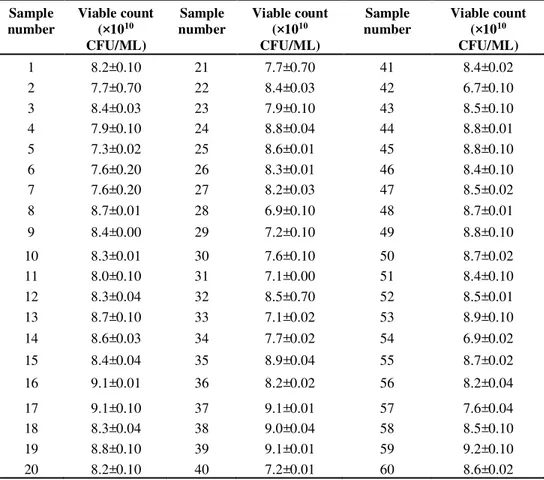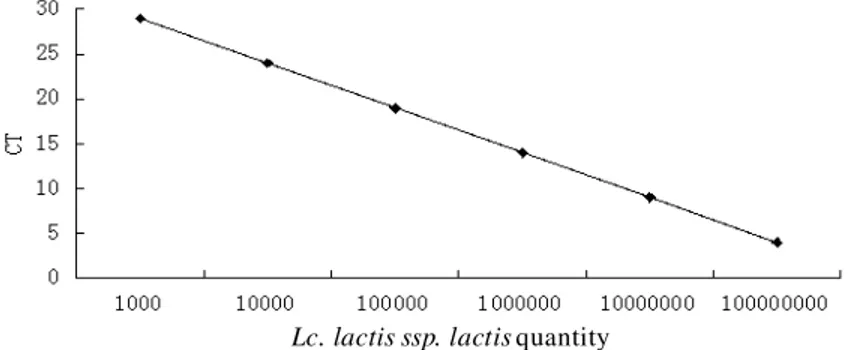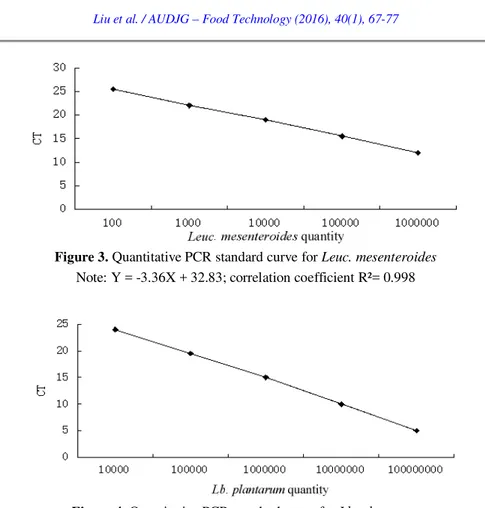Fascicle VI – Food Technology (2016), 40(1), 67-77
ORIGINAL RESEARCH PAPER
COMPOSITION OF LACTIC ACID BACTERIA IN DAIRY PRODUCTS
AND THEIR EFFECT ON TOURISM DEVELOPMENT OF
INNER MONGOLIA
MIN LIU1, QIONG SUN1*, AILI LIU2
1
Tourism Institute of Beijing Union University, Beijing, 100101, China;
2
College of Resource Environment and Tourism, Capital Normal University, Beijing 100048, China;
*Corresponding author: sunqiongsqsq@163.com
Received on 26th April 2016 Revised on 14th July 2016
In recent years, the development of dairy industry in Inner Mongolia has accelerated its economic growth, and its grassland culture has become appealing to the public. As an important support industry for the economic development in tourism area of Inner Mongolia, dairy industry can create economic value for the development of tourism. In view of the importance of dairy products-the habitat of lactic acid bacteria, this study aims to reveal the composition of lactic acid bacteria in dairy products and isolate lactic acid bacteria resources. Firstly, we selected 60 traditional dairy product samples (from the pasture in scenic area of Inner Mongolia) as the research objects. Based on the 16S rRNA gene sequence analysis, lactic acid bacteria in the samples were isolated and identified; Real-time quantitative polymerase chain reaction (q-PCR) technology was applied to the comparative analysis on the population of dominant bacteria in samples. It was found that there were significant differences in the numbers of dominant bacteria in different dairy products. With the advantages of improving nutritional value and extending storage time of dairy products, lactic acid bacteria is contributive to the development of dairy industry, which further promotes the prosperity of economy and tourism. Therefore, it is of great importance to study the composition of lactic acid bacteria in dairy products.
Keywords: dairy products, lactic acid bacteria, 16S rDNA, q-PCR
Introduction
industry) has been formed in Inner Mongolia, which enhances its
comprehensive economic strength, thus to provide a solid foundation for the
development of tourism industry (Feng and Jia, 2009). While the tourist
attractions are prospering in Inner Mongolia, more attention has been drawn to
the modernization and industrialization in the production of traditional
fermented dairy products as well as food safety issues. Accordingly, microbial
classification has become a hot topic in the researches on fermentation process
of traditional fermented dairy products. A lot of food (such as milk, soya bean
milk, pickled cabbage, apples, lactic acid drinks) contains lactic acid bacteria,
which can not only improve the nutritional value and flavor of food as well as
increase its preservation duration and additional value, but also have unique
biological activity and nutritional functions.
The biodiversity of lactic acid bacteria resources in China results from the vast
territory, changeable climate and distinctive techniques of different nations in
preparing traditional fermented dairy products (Khalaileh and Ajo,
2013).
Endowed with temperate grassland pasture and vast land, Inner Mongolia is
famous for producing high-quality dairy products which appeal to consumers.
Owing to the reputation of dairy industry, Inner Mongolia is also developing its
tourism industry and creating its tourism value (Mahrous
et al., 2013). At
present, a lot of experts, scholars and research institutions have carried out
relevant studies on the composition and diversity of lactic acid bacteria in dairy
products.
Duolan et al. (2009) performed a detailed study on the diversity of lactic acid
bacteria in naturally fermented milk from Chinese western minority areas,
Mongolia pastoral areas and regions of Russia; by isolating and identifying the
lactic acid bacteria from dairy products, they found that Lactobacillus was a
kind of dominant fungus. Ichikawa et al. (2011) isolated
Streptococcus
thermophilus from traditional fermented yak milk products (collected from
Inner Mongolia grassland in scenic region); through fermentation test, they
detected its fermentation, sensory and aroma-producing characteristics; finally,
they successfully screened bacterial strains with excellent fermentation
characteristics.
In brief, as an essential strain in the production process of fermented dairy
products, lactic acid bacteria is of high application value in food, health care,
industry and agriculture for their unique biological functions (Arendt
et al.,
2011). Dairy industry can promote the development of tourism industry in
Inner Mongolia, thus to promote economic growth.
Materials and methods
Samples
Table 1. Types and origin of 60 samples of traditional dairy products from Inner Mongolia
Type Serial number Origin
Yoghurt 1-34 Baiyanhua Town
Cream 35-44 Bayon Obo Sumu
Cheese 45-49 Ming’an Town
Fresh milk 50-60 Bailingmiao Town
Culture media and chemicals
The experimental reagents included bacterial growth media- MRS solid
medium (Wuxi SAV Teconology Co., Ltd.) and MRS broth, galactococcus
separation media— M17 solid medium annd M17 broth (Shanghai Hanni
Biotechnology Co., Ltd.), 10% skim milk protective agent, 0.5 M ethylene
diamine tetraacetic acid (EDTA), 10% sodium dodecyl sulfonate (SDS), 10 M
cetyltrimethyl ammonium bromide (CTAB), agarose, isopropyl alcohol
(Dalian Takara Technology Co., Ltd.), 10× TE buffer, proteinase K and NaAc
buffer.
Sample collection
1.5 ml of fermented milk was mixed with 0.5 g of sterilized neutralizer
(starch/CaCO
3, 50:1, M/M) in a sterile freezing tube; 5 g of solid sample was
collected with a sterilized spoon and added into a sterile freezing tube. All the
samples were labeled and sealed with sealing film; then, they were placed in a
portable refrigerator at 4°C.
Isolation and purification of lactic acid bacteria
200μl of dilut
ions (10
-5, 10
-6and 10
-7) were respectively added into
pre-prepared MRS and M17 solid media. The plate was placed in an anaerobic
incubator and cultivated at 30°C for around 48 hours. Labeled single bacterial
colony was selected with sterile inoculating loop and inoculated to the
corresponding MRS or M17 broth; then, it was cultured at 30°C for 24-48
hours. From the selected colonies, Gram staining test and microscopic
examination were performed. The strains were inoculated to MRS or M17
media for catalase test- colonies on solid media were placed in a clean test tube
and 2 ml of hydrogen peroxide solution (3%) was added. If bubbles appeared
within 30 seconds, the colonies were positive; otherwise, the colonies were
negative.
Real time q-PCR analysis of dominant bacteria in dairy products
Genomic DNA extraction from the dairy products
0.3 ml of SDS and
10 μl of proteinase K were added to the centrifuge tube
which was then placed in an orbital shaker (at 50°C, 300 rpm) for 2h;
afterwards, the tube was centrifuged at 12,000×g and 4°C for 10 min.
700 μl of chloroform was added to the collected supernatant;
after mixing, they
were centrifuged at 12,000×g and
4°C for 10 min; 80 μl of NaAc solution and
800 μl of ice isopropanol were added to the collected supernatant; after mixing,
they were centrifuged at 12,000×g and 4°C for 5 min; the supernatant was
removed and DNA sediment was obtained.
500
μl of ethanol was added to the DNA sediment; they were centrifuged at
8,000×g and 4°C for 5 min; the supernatant was removed, and the remaining
was placed in the air for natural drying;
40 μl of TE solution was added and
DNA was redissolved at room temperature. At last, using TE buffer, the
extracted genomic DNA solution was diluted to a concentration of 100
ng/μl
and preserved as standby.
Identification of lactic acid bacteria by q-PCR
ND-1000 spectrophotometer was used to determine the optical density (OD)
and concentration of DNA solution; then, the DNA diluent (10
-1-10
-8) was used
as template; specific primers (as shown in Table 2) were used for q-PCR
amplification. The reaction system is shown in Table 3.
Reaction conditions of q-PCR amplification are as follows (Josefsen
et al.,
2010; Pulford
et al., 2016): in the holding stage - 95°C, 20 s; in the cycling
stage - 95°C, 5 s; T
m°C, 40 s; 72°C, 50 s (40 cycles); 95°C; 15 s
; 75°C; 1 min
(T
mis the annealing temperature). After amplification, the standard curve was
drawn with software StepOiiev 2.3.
Table 2. Specific primers of q-PCR
Target bacteria Primer pairs
Oligonucleotide sequence Products size
Tm (°C)
Lb. plantarum Lp-F CAGAATTGAGCTGGTGGTGG 210 55
Lp-R TGTTACTTTCGCAACCAGAT
L. lactis ssp. lactis Lac-F ATGCGTAAACTTGCAGGAC 262 56
Lac-R CAACCTTGAATGGTGGAG
Leuc. mesenteroides Leu-F ATACAGGCGAACAGGGATTA 266 44
Leu-R GGGTGTAGTTTCTGGGTTTC
PCR amplification of 16S rRNA genes
FA-27F: 5’-gcagagttctcggagtcacgaAGAGTTTGATCCTGGCTCAG-3’
RA-1495R: 5’-agcggatcacttcacacaggaCTACGGCTACCTTGTTACGA-3’
(Scarpellini et al., 2001).
The lowercase primer sequences were used for sequencing.
Table 3. Quantitative PCR amplification system
Components Amount
SYBR 10 μl
50×ROX 0.4 μl
Primer F 0.4 μl
Primer R 0.4 μl
Template DNA (100ng/μl) 2 μl
ddH2O To 20 μl
Table 4. PCR amplification system of 16S rRNA genes
System components Amount
10×PCR buffer 5 µl
dNTPmix (10mmol/L) 4 µl
Primer FA-27F (10pmol/µL) 1.5 µl
Primer RA-1495R(10pmol/µL) 1.5 µl
Tap DNA polymerase(5U/µL) 0.5 µl
Template DNA(100ng/µL) 2 µl
ddH2O To 50 µl
Results
Lactic acid bacteria viability
Table 5 shows the viability rate of lactic acid bacteria in 60 traditional dairy
product samples collected from the pasture in Inner Mongolia scenic area.
As an important indicator, viable count reflects the freshness degree of dairy
products. The higher the viable count, the fresher the dairy products. With
high-concentration active bacteria, LAB products can play their roles more
efficiently.
PCR amplification results of 16S rRNA genes of isolates
accordingly, PCR amplified products of 16S rRNA gene of the isolates could
meet the requirements of the subsequent sequencing test.
Table 5. Viability rate of lactic acid bacteria in dairy products
Sample number
Viable count (×1010
CFU/ML)
Sample number
Viable count (×1010
CFU/ML)
Sample number
Viable count (×1010
CFU/ML)
1 8.2±0.10 21 7.7±0.70 41 8.4±0.02
2 7.7±0.70 22 8.4±0.03 42 6.7±0.10
3 8.4±0.03 23 7.9±0.10 43 8.5±0.10
4 7.9±0.10 24 8.8±0.04 44 8.8±0.01
5 7.3±0.02 25 8.6±0.01 45 8.8±0.10
6 7.6±0.20 26 8.3±0.01 46 8.4±0.10
7 7.6±0.20 27 8.2±0.03 47 8.5±0.02
8 8.7±0.01 28 6.9±0.10 48 8.7±0.01
9 8.4±0.00 29 7.2±0.10 49 8.8±0.10
10 8.3±0.01 30 7.6±0.10 50 8.7±0.02
11 8.0±0.10 31 7.1±0.00 51 8.4±0.10
12 8.3±0.04 32 8.5±0.70 52 8.5±0.01
13 8.7±0.10 33 7.1±0.02 53 8.9±0.10
14 8.6±0.03 34 7.7±0.02 54 6.9±0.02
15 8.4±0.04 35 8.9±0.04 55 8.7±0.02
16 9.1±0.01 36 8.2±0.02 56 8.2±0.04
17 9.1±0.10 37 9.1±0.01 57 7.6±0.04
18 8.3±0.04 38 9.0±0.04 58 8.5±0.10
19 8.8±0.10 39 9.1±0.01 59 9.2±0.10
20 8.2±0.10 40 7.2±0.01 60 8.6±0.02
Quantitative real-time PCR analysis results of dominant bacteria in dairy
samples
Standard curves
According to the test on OD values and the concentration of the standard DNA
fluid, it was found that the concentrations of all the standard fluid ranged between
100 and 3000 ng/µ L, and their purity was within the range of 1.8-2.0. Through
ten-fold dilution on the DNA fluid extracted from the samples of L. lactis ssp. lactis,
Leuc. mesenteroides and Lb. plantarum, the DNA diluent (10
-1~10
-8) was used as
Figure 1. Agarose gel electrophoresis of PCR amplified products of 16S rRNA genes of lactic acid bacteria isolates
Note: 1~12 refer to the PCR products of 16S rRNA genes of lactic acid bacteria isolates; M refers to DL 2000 DNA Markers.
Lc. lactis ssp. lactis quantity
Figure 2. Quantitative PCR standard curve of lactic acid subspecies of
L. lactis ssp. lactis
Note: Y= -4.83X + 42.81; correlation coefficient R²=0.996Quantitative PCR analysis of dominant bacteria in dairy products
Based on the standard curves, we calculated gene copies of L. lactis ssp. lactis,
Leuc. mesenteroides and
Lb. plantarum in yoghurt (samples 1-34), crea m
(samples 35-44) and cheese (samples 45-49). The average gene copies of
L.
lactis ssp. lactis
were respectively (9.4 ± 0.3) × 10
9copies/ML in yoghurt, (8.3 ±
Figure 3. Quantitative PCR standard curve for Leuc. mesenteroides Note: Y = -3.36X + 32.83; correlation coefficient R²= 0.998
Figure 4. Quantitative PCR standard curve for Lb. plantarum Note: Y = -4.68X + 47.26; correlation coefficient R²= 0.998
In the study, cows were the milk sources of all the dairy products. The
development of tourism in Inner Mongolia promotes its dairy consumption for
the well-known high quality of dairy products; further, cattle rearing is boosted
(Ashfield
et al., 2014; Giguet-Covex et al., 2014).
Meanwhile, the requirement
of dairy products in tourism area also increases. Consequently, it is of great
importance to improve the quality of dairy products and increase the
production, which will enhance the tourism value of Inner Mongolia.
Discussion
conducive to the cultivation of dominant bacteria and development of dairy
industry, thus to promote the double-development of local economy and
tourism industry (Tálas, 2015; Zhou et al., 2014).
In this study, 60 dairy products from Inner Mongolia scenic area were selected
as the research samples; quantitative PCR technology was applied based on the
theory of specific primers binding with fluorescent dye; amplification products
which were formed during PCR reaction were given real-time measurement so
that the microorganisms in samples were detected and quantified (Liu
et al.,
2014). Currently,
Lb. plantarum, L. lactis ssp. lactis, Leuc. mesenteroides have
been widely applied in the production of a variety of fermented dairy products,
providing solid guarantee for the rapid development of dairy industry.
Conclusions
There is a wide range of lactic acid bacteria in the dairy products of Inner
Mongolia. The types and quantity of lactic acid bacteria in traditional dair y
products are associated with the living environment and separation
environment. Endowed with rich grassland resources, cattle rearing industry in
Inner Mongolia is promoted; moreover, the yield and quality of dairy products
are improved, which provides a material basis for the development of tourism
value.
In summary, as an important member of probiotics family, lactic acid bacteria
are widely applied in health-care food as well as medicine. Owing to the health
care effects of the physiological activity, metabolites and bacterial components
of lactic acid bacteria, the application of lactic acid bacteria is of great
significance to the development of dairy industry, which in return promotes the
development of economy and tourism industry in Inner Mongolia (Xie
et al.,
2015).
References
Arendt, E. K., Moroni, A., Zannini, E. 2011. Medical nutrition therapy: use of sourdough lactic acid bacteria as a cell factory for delivering functional biomolecules and food ingredients in gluten free bread. Microbial Cell Factories, 10, 1-9.
Ashfield, A., Wallace, M., Crosson, P. 2014. Economic comparison of pasture based dairy calf-to-beef production systems under temperate grassland conditions. International Journal of Agricultural Management,3(3), 175-186.
Duolan, Huercha, Ichikawa, O., Hotchi, K., Nakamura, M. 2009. A Study of rural household biogas technology for livestock production and dairy farming in Inner Mongolia Autonomous region of China. Journal of the College of Dairying Cultural & Social Science, 34, 51-61.
Giguet-Covex, C., Pansu, J., Arnaud, F. 2014. Long livestock farming history and human landscape shaping revealed by lake sediment DNA. Nature Communications, 5(2), 3211-3211.
Hirata, M., Nam, T., Ogawa, R. 2015. Milk processing system of Amdo Tibetan pastoralists in Qinghai, China: From the case of a settled nomadic household and an agro-pastoral household in the eastern Qinghai. Milk Science,64, 7-13.
Ichikawa, O., Nakamura, M., Katagiri, S. 2011. The deployment of the company-dairy management in Inner Mongolia Autonomous region of China. Journal of the College of Dairying Cultural & Social Science, 35(2), 29-41.
Josefsen, M.H., Löfström, C., Hansen, T.B. 2010. Rapid quantification of viable campylobacter bacteria on chicken carcasses, using real-time PCR and propidium monoazide treatment, as a tool for quantitative risk assessment. Applied & Environmental Microbiology, 76(15), 5097-104.
Khalaileh, N.A.A., Ajo, R.Y. 2013. Production of processed spread cheese supplemented with probiotic bacteria and studying growth and viability under different storage conditions. Carpathian Journal of Food Science & Technology, 5(1),13-22.
Liu, M., Liu, G., Zheng, X. 2014. Spatial pattern changes of biomass, litterfall and coverage with environmental factors across temperate grassland subjected to various management practices. Landscape Ecology,30(3), 477-486.
Mahrous, H., Mohamed, A., El-Mongy, M.A., EI-Batal, A.I., Hamza, H.A. 2013. Study Bacteriocin Production and Optimization Using New Isolates of Lactobacillus spp. Isolated from Some Dairy Products under Different Culture Conditions. Food & Nutrition Sciences, 2013, 04(03), 342-356.
Mushtaq, M., Gani, A., Masoodi, F.A., Ahmad, M. 2016. Himalayan cheese (Kalari/Kradi) – Effect of different probiotic strains on oxidative stability, microbiological, sensory and nutraceutical properties during storage. LWT - Food Science and Technology,67, 74-81.
Pagan, R., Price, N., Prasad, P. 2010. Managing the environmental impact of the dairy industry: The business case for sustainability. Improving the Safety & Quality of Milk,
189(1), 252-282.
Pulford, D.J., Gias, E., Bueno, I.M., Mcfadden, A. 2016. Developing high throughput quantitative PCR assays for diagnosing Ikeda and other Theileria orientalis types common to New Zealand in bovine blood samples. New Zealand Veterinary Journal,
64(1), 1-28.
Scarpellini, M., Mora, D., Colombo S. 2001. Development of genus/species-specific PCR analysis for identification of carnobacterium strains. Current Microbiology,45(1), 24-29.
Stuart, D., Schewe, R.L., Gunderson R. 2013. Extending Social Theory to Farm Animals: Addressing Alienation in the Dairy Sector. Sociologia Ruralis,53(53), 201-222. Tálas, D. 2015. Financial competitiveness analysis in the Hungarian dairy industry.
Competitiveness Review An International Business Journal Incorporating Journal of Global Competitiveness, 25(4), 426-447.





